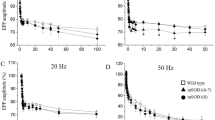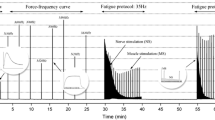The function of synaptic transmission and presynaptic vesicular cycle in the neuromuscular synapses of the diaphragm was studied in transgenic APP/PS1 mice (Alzheimer’s disease model). The decrease in the quantal content of end-plate potential, intense depression of the amplitude of terminal plate potentials under conditions of lasting high frequency stimulation (50 Hz), a drastic prolongation of the synaptic vesicle recycling time in APP/PS1 mice in comparison with wild type mice were detected. Manifest dysfunction of the neuromuscular synapses, caused by disordered neurosecretion and recycling of the synaptic vesicles in the presynaptic nerve endings, was detected in the Alzheimer’s disease model on transgenic APP/PS1 mice. The study supplemented the notions on the pathogenesis of Alzheimer’s disease as a systemic disease, while the detected phenomena could just partially explain the development of motor disorders in this disease.
Similar content being viewed by others
References
Mukhamedyarov MA, Volkov EM, Leushina AV, Kochunova YuO, Palotas A, Zefirov AL. Ionic and molecular mechanisms of β-amyloid-induced depolarization of the mouse skeletal muscle fibres. Ross. Fiziol. Zh. 2011;97(8):795-803. Russian.
Mukhamedyarov MA, Zefirov AL. The Influence of β-Amyloid Peptide on the Functions of Excitable Tissues: Physiological and Pathological Aspects. Uspekhi Fiziol. Nauk. 2013;44(1):55-71. Russian.
Hebert LE, Bienias JL, McCann JJ, Scherr PA, Wilson RS, Evans DA. Upper and lower extremity motor performance and functional impairment in Alzheimer’s disease. Am. J. Alzheimers Dis. Other Demen. 2010;25(5):425-431.
Kuo YM, Kokjohn TA, Watson MD, Woods AS, Cotter RJ, Sue LI, Kalback WM, Emmerling MR, Beach TG, Roher AE. Elevated abeta42 in skeletal muscle of Alzheimer disease patients suggests peripheral alterations of AbetaPP metabolism. Am. J. Pathol. 2000;156(3):797-805.
Mukhamedyarov MA, Grishin SN, Yusupova ER, Zefirov AL, Palotás A. Alzheimer’s beta-amyloid-induced depolarization of skeletal muscle fibers: implications for motor dysfunctions in dementia. Cell. Physiol. Biochem. 2009;23(1-3):109-114.
Mukhamedyarov MA, Teplov AY, Grishin SN, Leushina AV, Zefirov AL, Palotás A. Extraneuronal toxicity of Alzheimer’s β-amyloid peptide: comparative study on vertebrate skeletal muscles. Muscle Nerve. 2011;43(6):872-877.
Querfurth HW, LaFerla FM. Alzheimer’s disease. N Engl. J. Med. 2010;362(4):329-344.
Rizzoli SO, Richards DA, Betz WJ. Monitoring synaptic vesicle recycling in frog motor nerve terminals with FM dyes. J. Neurocytol. 2003;32(5-8):539-549.
Scarmeas N, Albert M, Brandt J, Blacker D, Hadjigeorgiou G, Papadimitriou A, Dubois B, Sarazin M, Wegesin D, Marder K, Bell K, Honig L, Stern Y. Motor signs predict poor outcomes in Alzheimer disease. Neurology. 2005;64(10):1696-1703.
Selkoe DJ. Alzheimer’s disease is a synaptic failure. Science. 2002;298:789-791.
Sheng M, Sabatini BL, Südhof TC. Synapses and Alzheimer’s disease. Cold Spring Harb. Perspect. Biol. 2012;4(5). pii: a005777. doi: https://doi.org/10.1101/cshperspect.a005777.
Swanberg MM, Tractenberg RE, Mohs R, Thal LJ, Cummings JL. Executive dysfunction in Alzheimer disease. Arch. Neurol. 2004;61(4):556-560.
van Halteren-van Tilborg IA, Scherder EJ, Hulstijn W. Motorskill learning in Alzheimer’s disease: a review with an eye to the clinical practice. Neuropsychol. Rev. 2007;17(3):203-212.
Zefirov AL, Abdrakhmanov MM, Mukhamedyarov MA, Grigoryev PN. The role of extracellular calcium in exo- and endocytosis of synaptic vesicles at the frog motor nerve terminals. Neuroscience. 2006;143(4):905-910.
Zefirov AL, Zakharov AV, Mukhametzyanov RD, Petrov AM, Sitdikova GF. The vesicle cycle in motor nerve endings of the mouse diaphragm. Neurosci. Behav. Physiol. 2009;39(3):245-252.
Author information
Authors and Affiliations
Corresponding author
Additional information
Translated from Byulleten’ Eksperimental’noi Biologii i Meditsiny, Vol. 165, No. 5, pp. 614-619, May, 2018
Rights and permissions
About this article
Cite this article
Mukhamedyarov, M.A., Grigor’ev, P.N., Ushanova, E.A. et al. Dysfunction of Neuromuscular Synapses in the Genetic Model of Alzheimer’s Disease. Bull Exp Biol Med 165, 669–673 (2018). https://doi.org/10.1007/s10517-018-4238-z
Received:
Published:
Issue Date:
DOI: https://doi.org/10.1007/s10517-018-4238-z




